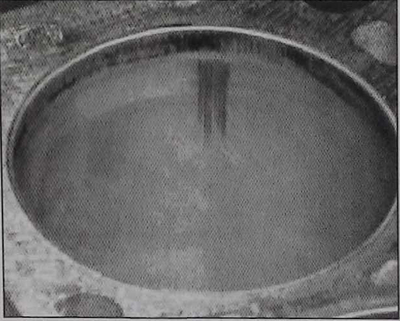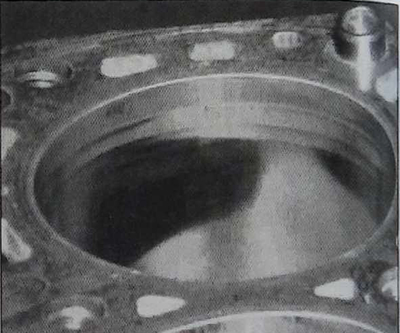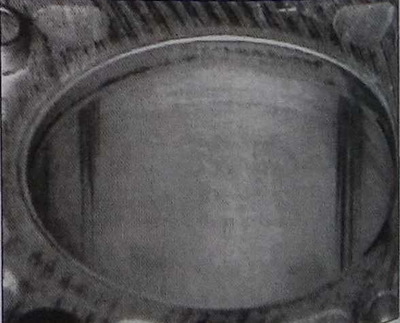Note. In this case, repair operations are shown for four-cylinder gasoline and diesel engines with a volume of 2.0 liters. Procedures for smaller engines are similar. For technical information on the components of the cylinder block and cylinder head as a whole, see chapter «Data for adjusting and monitoring the mechanical part of petrol and diesel engines».
Cylinder mirror check (glossy areas, wear)

Separate shiny areas, for example in the middle of the cylinder or in the area of the bolts of the cylinder head, should not cause concern. In this case, the cylinder block can be reused.
Visible marks, traces of friction

They appear as emanating from the top dead center zone of the upper piston ring and downward and are the result of dry friction resulting from the washing off of the oil film by the fuel, for example, during frequent starts of a cold engine in short-distance vehicle operation.
These «smoothed» traces of friction that occur on the mirror of the cylinder, mainly in the area of \u200b\u200bthe bolts of the cylinder head and in the area of \u200b\u200blateral pressure of the piston skirt, are within the normal range.
If the piston rings are not damaged, then the cylinder block is suitable for further use.
Ring impressions
They appear as visible impressions on the cylinder mirror in the area of the upper and lower dead spots of the piston rings and are also not critical. In this case, the cylinder block is also suitable for further use.

Shiny, reflective, polished areas around the circumference of the cylinder mirror

They appear as marks emanating from the top dead center zone of the upper piston ring, and are usually accompanied by partial wear of the cylinder. In this case, the cylinder mirror is unsuitable for further use (repair or replace the cylinder block).
Rough marks, friction marks

Traces starting from the first and second piston rings and disappearing only at the bottom of the cylinder. Such progressive friction marks lead to the formation of friction scoring.
If such traces are visible (e.g. felt when touched), cylinder mirror unsuitable for further use (repair or replace the cylinder block).
Note. With this defect, piston rings can be damaged.
Separate continuous scratches
They usually appear when dirt enters the combustion chamber, for example, as a result of the back pulsation of soot particles from the exhaust system. In this case, the cylinder block can be reused.
Piston Seizures
With this defect, as a rule, the cylinder mirror has a noticeable roughness along the entire length, there are also noticeable) material transfer and tangible scuff marks on the cylinder bore and piston skirt. In this case, the cylinder mirror is unsuitable for further use (repair or replace the cylinder block).
Darkening of the cylinder surface
Darkening over large areas of the cylinder mirror is oil «lacquer» deposits and indicates engine operation in high temperature conditions. In this case, the cylinder block is suitable for further use in the absence of unacceptable deformation of the cylinders. Oily «lacquer» deposits on top of the piston ring area are considered normal and should not be considered as a fault.
